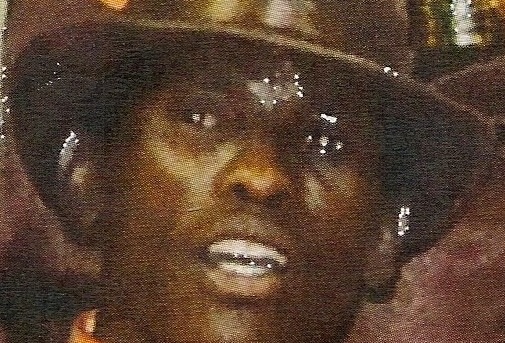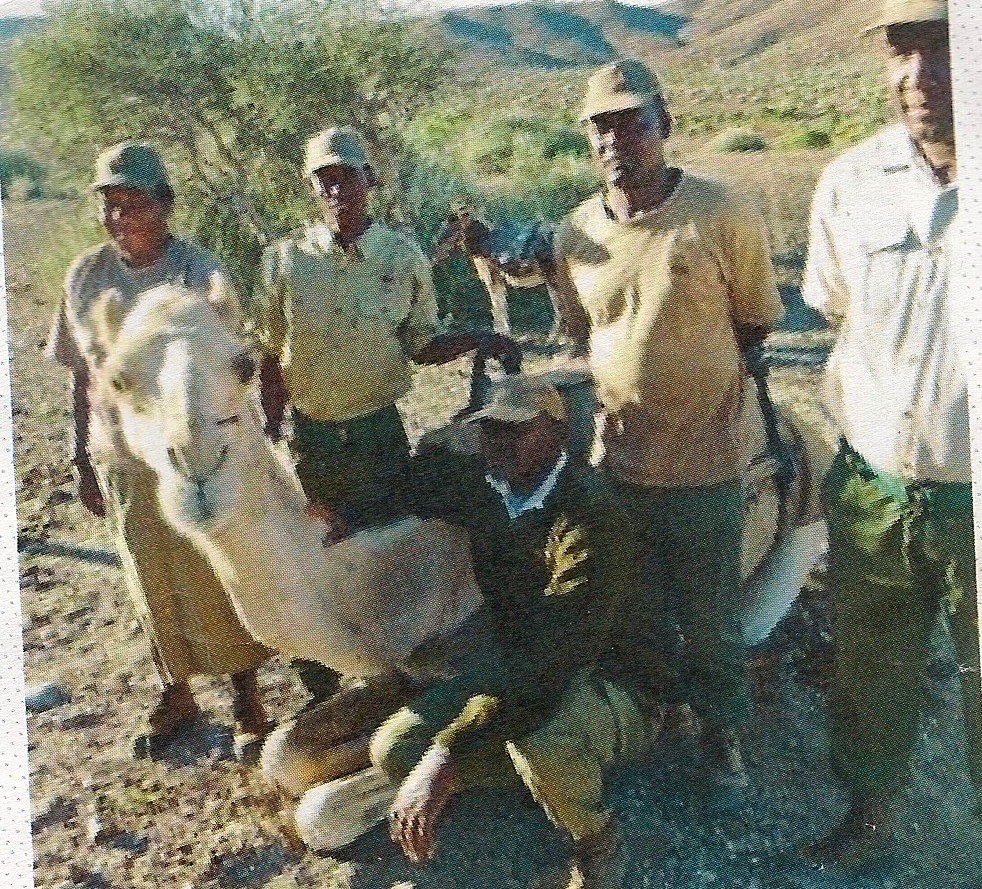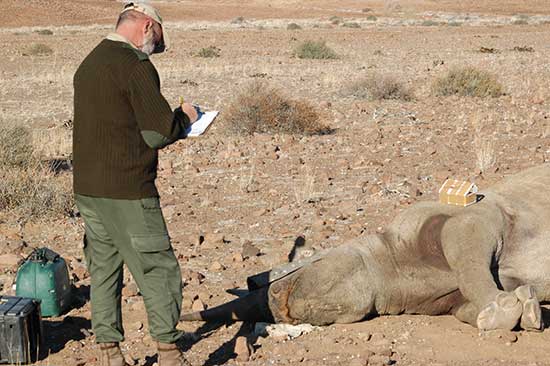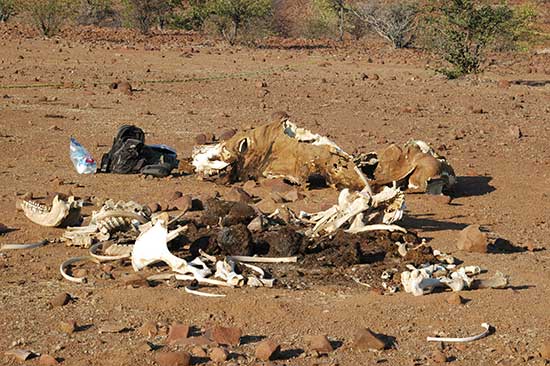
20 Nov Strange death of a rhino protector
How did ‘Boxer’ die? Why are dead rhinos being found in the area his team patrolled? John Grobler digs up strange secrets surrounding the deaths of black rhinos in the Kunene region of Namibia

Daniel Alfeus //Hawaxab – aka Boxer
The air over Sesfontein this time of year is usually a peculiar metallic hue, tinged by the talcum-fine dust whipped by the harsh desert wind blowing from the Skeleton Coast, 250 kilometres away to the west.
But today, the white heat seemed bleaker than ever, and another metallic taste stirred in the air: that of blood, redolent of greed and betrayal, of witchcraft and a strange death by anthrax. Boxer was dead.
As the oldest and most experienced tracker of the three-man Save the Rhino Trust’s (SRT) Damara-speaking team, Daniel Alfeus //Hawaxab – aka Boxer – was by all accounts an exemplary employee. At age 37, he had spent his entire adult life looking out for the world’s last free-roaming black rhinos of the Kunene region.
His knowledge of the rugged mountains and deep valleys, watered by secret fountains where the last free black rhinos live, played a major role in the recovery of their numbers after the 1980s slaughter during the South African occupation that left fewer than 20 animals alive. Their numbers now are officially kept secret to deter poachers – but the secrecy also serves to obscure the true state of affairs.
For 20 years, after the last reported case at Mbkondja in 1993, there had been no rhino poaching, as the SRT’s tactics of constantly patrolling the rhino ranges kept the poachers at bay. But on Christmas Day 2012, the first of 14 carcasses found so far started turning up in the field, at the Kommagorras fountain near Mbkondja.
Mbkondja – a Herero word meaning “struggle” – is a scattered communal farming settlement, roughly halfway between Palmwag and Khowarib, and is where the SRT keeps camels used for foot patrols into the mountains.
Boxer was on the scene quickly and identified a former soldier-turned-cattle herder named Tjihuure Tjiuamba as the most likely suspect. He and two community game guards interrogated him – Boxer was a man known to talk with his hands when necessary, hence his nickname – and Tjiuamba soon pointed out where he had hidden the horns.
He also deposed a sworn affidavit a few weeks later to the police’s Protected Resources Unit, in which he implicated his employer, Efraim Mwanyangapo, as offering him R30 000 for rhino horn and supplying him with two .303 bullets for a rifle he then stole from a man named Jakotwa, he stated.
Jakotwa, a Himba farmer who also kept cattle at Mbkondja, independently confirmed this version. But he has moved away now – there were bad things at Mbkondja he did not want to discuss.
Tjiumba later withdrew his statement in court, claiming it was made under duress. Boxer’s actions, however, provided the legal ground for what has been the only successful prosecution so far, 24 black rhinos later.
So it was strange that no one in the SRT made any effort to get Boxer to the hospital in Opuwo as he lay dying in Sesfontein’s clinic, and that most of colleagues, including all SRT’s management, did not attend his funeral in Sesfontein.
Boxer died alone, in agony. And that had everyone spooked.
Death certificate
The case closely matched the 1993 case, said Rudi Loutit, former chief game warden of Kunene whose wife, Blythe, founded the SRT: three lo-cals arrested, but the state witness was threatened with death. In court, he claimed to have been assaulted (even though Loutit hid him away at Möwe Bay for four months at own expense), and the case collapsed immediately. The culprits walked free and returned to Mbkondja.
Fast forward 21 years: four days after their last patrol ended on Tuesday, September 30 2014, Boxer started complaining of stiff joints and painful glands when he returned to his small, mud-walled house in Sesfontein.
“He had a thing like a boil on the inside of his arm, a strange colour. He said he could not even lift a spade,” his aunt, Linda //Hawaxab, recalled later.
On that Saturday, the strange-looking blister started spreading rapidly on his upper inside left arm, spreading to the rest of his arm in discoloured lumps down to his wrist. The nurse at the local clinic treated him for a possible snake or spider bite, but by Sunday a huge blue-black sac had formed on his left chest.
Ice-packs and painkillers were administered, but by Monday night he started vomiting and having trouble breathing as the strange black infection spread across his abdomen, various friends and family related.
“I went to see him in the hospital on Monday. He was struggling to breathe, he could not really talk anymore. You could see that he was finished,” an SRT colleague, Ludwig “Mannetjies” Ganuseb, told me six days later.
Others said in his last moments of clarity, Boxer told them his mysterious illness was caused by those involved in the rhino poaching.
Early Tuesday morning, after four days of fighting for his life, the veteran tracker of 20-odd years and in the prime of his life finally lost the battle against the poison coursing through his body. His corpse had to be sent to the state hospital in Opuwo, 150km north, for a death certificate to be issued.
For some reason, the SRT, his employer of the past two decades, could not make any of their four vehicles available. The family instead had to take up a collection for petrol and borrow local councillor Hendrik Goamab’s battered 30-year-old pick-up to transport the body to Opuwo’s mortuary late that Tuesday. Boxer had no wife or children of his own, so his nephew accompanied the body for the four-hour drive.

Desert patrol: Boxer is the guy in the middle, crouching next to the camel. “Mannetjies” Ganuseb is standing behind him
By the time the overworked, new state doctor could attend to his case, Boxer had been dead for two days. No one examined the body, because in 35-degree heat and the body already in such bad state, there simply was no point to do so, hospital staff said.
The death certificate, issued on October 7 2014, simply noted the cause of death as “unknown.”
When Boxer”s symptoms were described to the matron of the Opuwo hospital, Lukas Ashivudhi, he immediately recalled seeing similar symptoms among villagers in a remote Kunene village who got anthrax poisoning. Big black-green lumps under the skin spread through the limb and then the rest of the body.
Pressed for more information, Ashuvudhi became nervous. Only the permanent secretary could disclose such information, he said, and put the phone down.
The deputy permanent secretary of the Ministry of Health and Social Services, Dr Norbert Foster, confirmed the remote village was Orupem-be, 208km north-west of Sesfontein, where villagers contracted anthrax after eating meat of an infected animal that died during the 1992 drought.
Boxer’s symptoms as described, he concurred, matched those of the Orupembe villagers.
Anthrax, so named after the Greek word for coal because of the lumpy, black discolouring that it causes in the limbs of the victim, is common in this area and is sometimes called “hide carriers’ disease,” said veterinarian Dr Conrad “Nad” Brain. As the former chief state veterinarian of the Etosha Game Park, which abuts Kunene to the east, he had handled “hundreds and hundreds” of anthrax case among animals, as well as the odd human case, he said.
Anthrax
In humans, anthrax can manifest as a pulmonary infection from breathing in spores, a gastrointestinal eruption from eating infected meat and, most commonly, a cutaneous infection in the area of the body where it entered the body.
According to the United States Centre for Disease Control and Preven-tion, anthrax infection in humans presents as an ulcer-like boil, called an eschar, at the site of infection within two to five days of infection. If untreated, it leads to death within days by toxemia, caused by the massive release of two lethal exotoxins and a bacterial toxin via the host body’s lymphatic system. The fatality rate in untreated cases is 92%; even in observed cases, where medical treatment is administered, the mortality rate is 45%.
Brain said anthrax was easy to diagnose, provided you had a micro-scope and knew what to look for. “However, it very often gets misdiagnosed. I often can spot it long before medical doctors do, because they look for what the patient thinks the cause of the problem could be.” Once identified, it was easily treatable with a specific but commonly available antibiotic, he said.
Dark talk
Back in Sesfontein, there was trouble among the //Hawaxab and Ga-nuseb clans. Another //Hawaxab had died in the same week (of unrelated causes), and she was to be buried at the same time as Boxer. At the church service, accusations and counter-accusations started flying, and the police had to be called in to restore order.
No one would really say what the problem was: one said it was because someone from the Ganuseb clan bad-mouthed the dead woman, others said it had to with inheritance issues involving Boxer’s earthly goods. Fingers were being pointed, and tempers flared.
What struck the local community was that none of the senior SRT management, like CEO Simpson Uri-Khob or director of special operations Bernd Brell, attended the funeral in the dusty and decrepit Sesfontein graveyard.
People also noticed the absence of the Ganaseb brothers Hans and Mannetjies. Mannetjies was seen drinking all the next day at the local bar owned by Mwanyangapo, situated at the small business complex he co-owned with his Chinese partner, Paul Hoa.
Among the extended family – in this tiny, isolated community of some 3 000 people, everyone is related in one way or another – there was darker talk: Mannetjies and his brother Hans, who both live in Mbkondja where they keep their small stock, were questioned for 12 hours by the police’s protected resource unit last month in connection with the sud-den outbreak of poaching in their back yard over the past two-and-a-half years.
The carcasses kept turning up in the wake of SRT patrols that somehow managed not to see them. Most were found by cattle herders – so why were the SRT patrols missing them?
A senior law enforcement official confirmed this: there was talk of one of the Ganasebs having bought a new car, which he clearly could not afford on his monthly R1 500 salary.
Both Ganasebs were moonlighting as hunting guides in their spare time for Peter Thormählin, a South African professional hunter blacklisted in South Africa for his involvement in pseudo-hunts of rhinos. The Namibian Professional Hunters Association had also expelled him, they said in an unusually strongly worded statement.

The Kunene region
Mannetjies had made it clear that he intended becoming rich, and had gone to the Angolan witchdoctor Muanyamengi to get muti which he openly used, local sources claimed.
Belief in witchcraft was very strong. “You white people don’t believe us blacks about witchcraft because we are poor,” burst out Elifas Tjavindja, a community game ranger of somewhat spotty reputation.
Everyone knew that in the early 1990s, when the SRT and police caught some poachers here, all seven of those involved in the bust died over the next year, he said (it turned out to be not true). “There is very powerful medicine here, a very powerful Angolan witchdoctor. You must watch out!”
Muanyamengi, encountered at the Warmquelle shebeen (also owned by Mwanyangapo) on a Sunday night about a week before Boxer went on his last patrol, described himself as a doctoure tradicional (traditional doctor). He said he does lots of work for important, rich people and was in the Angolan commando forces during the war.
At the Ganaseb-//Hawaxab homestead, a motley collection of zinc lean-tos, mud huts and one small concrete house on the eastern outskirts of the settlement, there was no talk initially of witchcraft. When we arrived there the day after the funeral to pay respects and inquire about the cause of Boxer’s shockingly sudden death, Mannetjies jumped up and steered this reporter away from the rest of the people. “Let’s talk over there alone, not here among everyone. It will just upset everyone,” he insisted.
Boxer, he confided, was bitten on Saturday by something in his bedroll, here in his house in Sesfontein – maybe a snake or a spider, he repeated several times. Definitely something bit him, which caused that ulcer-ous sore to start developing.
But on the inside of his upper left arm? Someone who had spent half his adult life out in the veld, among mambas, puff adders, cobras and any variety of scorpions, and never been bitten before? How could he have missed seeing whatever it was that was in his bedroll that bit him?
Mannetjies” eyes, blood-shot and blurred from an obvious hang-over, flickered and shifted as he flashed his trademark brilliant white smile. “Something bit him,” he said a little louder.
His eyes clouded over at a suggestion we would question the Sesfontein Clinic’s chief nurse about what kind of bug could be so deadly it would kill a strong, fit man in three days.
“You must come and tell us what they say at the hospital,” he urged, leaning closer. “Don’t forget to come and tell us. I will wait here for you.” It was an appointment neither of us would keep.
The chief nurse was cranky, upset at being woken just before noon on a Sunday, and wouldn’t supply a name. My guide had warned she was a former combat nurse with Plan (People’s Liberation Army of Namibia, ruling party Swapo’s former guerrilla army) and could be quite difficult.
She vaguely confirmed Boxer’s symptoms with grunts and cryptic answers: many poisonous things in the bush. Snakes and spiders.
Bush telegraph
Did Boxer say anything about being bewitched by the people he had helped put in jail? Had she seen anything like this before?
Angrily, she burst out: “Oh, you people. Just leave us alone. You only care about the rhino, not about people.” Excuse me? “I just want the maaaahny. If I get a rhino, I will just sell it. I need a million. Then all my problems will be solved,” she said.
Even at the risk of jail? I was shooed away with an imperious wave.
A day later, at the SRT’s trackers’ camp at Palmwag, some trackers were preparing for patrol. “We’re going to get those poachers,” one vowed cheerfully.
But the mention of Boxer’s name brought a cold wariness – and no one could recall any other tracker dying in the same way Boxer did. And why would only one person out of that team get ill? Silence ensued, no one would meet my eyes. “I think a snake,” said Lesley Gariseb, kicking at the dust.
And no, the CEO and director of special operations were not there, as with four previous visits. Nor did any of them return calls or numerous text messages.
While the bush telegraph kept pinging in Mbkondja about the cause of and suspects in Boxer’s death, the SRT management appeared to have disappeared and the Ministry of Environment and Tourism stonewalled. Only the Permanent Secretary could answer questions, and no, he was not available.
A week later, the really bad news: a radio-collared black rhino was killed inside the Etosha Park, close to the fence with Kunene where the road leads up to Opuwo from the south. On November 19 three more black rhino carcasses were discovered in Etosha.
And where was Muanyamengi, the powerful Angolan witchdoctor? Word had it he had moved on to Orupembe, where an elephant was reported to have died of anthrax recently. After that, he was seen in Opuwo, drinking heavily.
Through a former director of the SRT, contact was quietly established with one SRT member still considered trustworthy. Why was it that dead rhinos were only being found in the area that Boxer’s team patrolled, I asked. Was his death connected to the poaching?
“Yes. But that secret got buried with Boxer,” came the answer after a long silence. – oxpeckers.org


